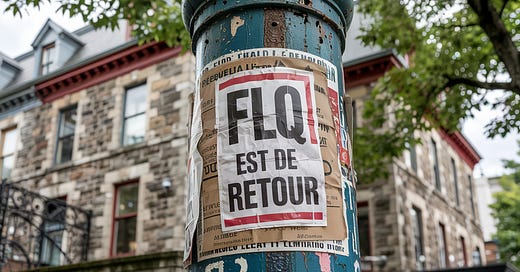This is part three in our ongoing choose-your-own adventure series. You can read all three here.
Resistance didn’t come all at once. It flickered to life in pockets and margins—on dirt roads and encrypted channels, in grocery line whispers and roadside glances. But it was growing. Fast.
The Trump regime moved quickly to consolidate control. In a video address that aired across both Facebook and X, Trump announced that Pierre Poilievre had been appointed Interim Governor of Canada—his words, not the country’s. The purpose, Trump said, was to “oversee the peaceful dismantling of the old Canadian government and the smooth integration of the region into the United States.”
Poilievre, flanked by a mix of U.S. officials and newly promoted Canadian loyalists, vowed to “return order and opportunity” to what he called a “confused and collapsing country.”
But the real gut punch came in the second half of the announcement: the suspension of Canadian rule of law.
“This is a new beginning,” Trump said. “We’re piloting a program that will automate law enforcement using the latest in AI and predictive justice. No more activist judges. No more political policing. Just fair, fast, and final decisions. Our Canadian partners in law enforcement and the judiciary are eager to help make this a success.”
What he didn’t say outright—but what everyone understood—was that this wasn’t just about policing. It was about ideological enforcement. The system would be trained to recognize “threats to order,” which meant anyone opposing the new regime. Anyone asking questions. Anyone organizing.
And people were organizing.
Across Saskatchewan, farmers who had quietly rejected Premier Moe’s alignment with the Americans began forming co-ops and resistance cells. Their plan wasn’t just to survive—but to subvert. Grain and meat were rerouted away from state-supported markets and toward underground distribution networks. Convoys of food moved quietly by night. Some began blocking key highways, daring enforcement drones to intervene.
In Quebec, the FLQ—long dormant—reemerged. Their communiqués came first as grainy PDFs passed through secure messaging apps followed by posters in the streets. Then came the explosions: a small rail bridge in the Eastern Townships, a communications tower outside of Lévis. They had unearthed weapons and explosives buried since the 1970s. No one saw it coming. Least of all the Americans.
The occupiers had made a critical mistake. They treated Canada as if it were a monolith—as if it could be absorbed like a 51st state. But Canada had never been one thing, and in its diversity, it found strength. The regional fault lines that had once divided the country were now becoming arteries of resistance.
In smaller communities, where Proud Boy-style militias now roamed unchecked, intimidation reigned. With the border officially erased, American extremists began crossing freely, targeting libraries, community centers, and anyone they deemed “unpatriotic.” These acts were filmed, shared, and often rewarded by the algorithms.
And still the question lingered: What happened to the Canadian military?
The answer came in fragments. Leaks. Voice notes. Testimonies.
It turned out the U.S. had prepared well in advance. Canadian Forces bases had been infiltrated, with key command and signals units quietly neutralized or flipped. In many cases, the Americans didn’t even have to fire a shot—they just took over the chain of command.
But they made one crucial error: they didn’t understand Quebec. Language, culture, and history created a blind spot. In Quebec, military units refused to comply. Many deserted. Many more aligned themselves with the resurgent FLQ, bringing tactical knowledge, equipment, and coordination the movement had never had before.
The insurgency had arrived.
Then came the rallying point. In an international press release posted to decentralized networks and picked up by rogue media outlets, a coalition of First Nations formally rejected Trump’s proposed mining deals. They announced the creation of Indigenous resistance groups, rooted in traditional governance and sovereignty.
One statement from the Wet’suwet’en simply read: We do not consent. We never have. We will not let you tear apart the land again.
In the north, the land was already speaking. And people were listening.
Across what was once Canada, a single question began to spread:
How do I join?
How can I help?
Where do I go?
No one waited for orders. They started organizing. They started resisting.
The fire in the north had been lit.
And it was not going out. Fan the flames by sharing this issue:
Post a comment Re: how you would like this story to continue…







Along the BC Coast and mountains, the Thunderbird is seen....
That bit about the roaming militias reminded me of how Octavia Butler in the Parables books simply imported into southern Californnia things Central & South Americans have lived with for a long time already: rapacious corporations, company towns, & emboldened paramilitaries who feel sanctioned both by God & government. I think the other interesting insight from those books was that where the stresses caused by climate change were less brutal, more people engaged in the more passive but somewhat effective resistance of just not cooperating, which is a luxury more available to those less desperate, less besieged. I think class would inflect this resistance as significantly as regional differences & that might be interesting to explore